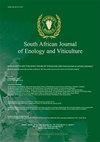Evolution of Phenolic Content, Antioxidant Capacity and Phenolic Profile during Cold Pre-fermentative Maceration and Subsequent Fermentation of Cabernet Sauvignon Red Wine
IF 1.1
4区 农林科学
Q4 FOOD SCIENCE & TECHNOLOGY
引用次数: 10
Abstract
The phenolic compound profile and content of red wines are modified during the maceration-fermentation process by several factors that alter the extractability of the compounds and by reactions that phenolic compounds undergo, and can be directly related to the quality of the final wine and its beneficial effects on the consumer. The aim of this study was to determine the change in phenolic content and profile during cold pre-fermentative maceration and fermentation without the removal of grape pomace. Total phenolics, flavonoids, anthocyanins, tannins and antioxidant capacity were determined by spectrophotometric methods, and the phenolic profile was determined by HPLC-MS on each day of the maceration-fermentation process. The results showed a variation in the content of phenolic compounds and antioxidant activity over time, but the final phenolic content showed no significative difference compared with the initial content (1 268 mg GAE/L and 1 115 mg GAE/L respectively). The phenolic profile showed that flavonoids were the principal compounds in wine and that they increased at the end of the winemaking. Condensed tannins also increased during fermentation, while anthocyanins and some phenolic acids decreased at the end of the process. The final content of phenolic compounds was similar to the initial one, but there was a change in the different fractions of phenolic compounds at the end of fermentation.赤霞珠红葡萄酒低温预发酵及后续发酵过程中酚类物质含量、抗氧化能力和酚类物质的变化
在浸渍发酵过程中,通过改变化合物可提取性的几个因素以及酚类化合物所经历的反应,红葡萄酒的酚类化合物特征和含量会发生变化,这可能与最终葡萄酒的质量及其对消费者的有益影响直接相关。本研究的目的是确定在不去除葡萄渣的情况下,冷预发酵浸渍和发酵过程中酚类物质含量和分布的变化。采用分光光度法测定总酚类、黄酮类、花青素、单宁和抗氧化能力,并采用HPLC-MS法测定浸渍发酵过程中每天的酚类成分。结果表明,酚类化合物含量和抗氧化活性随时间变化,但最终酚类含量与初始含量(分别为1268mg GAE/L和115mg GAE/L)相比没有显著差异。酚类物质分析表明,黄酮类化合物是葡萄酒中的主要化合物,并且在酿酒结束时含量增加。浓缩的单宁在发酵过程中也增加了,而花青素和一些酚酸在发酵过程结束时减少了。酚类化合物的最终含量与最初的含量相似,但在发酵结束时,不同组分的酚类化合物发生了变化。
本文章由计算机程序翻译,如有差异,请以英文原文为准。
求助全文
约1分钟内获得全文
求助全文
来源期刊
CiteScore
2.50
自引率
7.70%
发文量
1
审稿时长
>36 weeks
期刊介绍:
The South African Journal of Enology and Viticulture (SAJEV) publishes full-length original Research Papers, Research Notes and Review Papers on all subjects related to enology and viticulture. The SAJEV does not accept articles published in, or submitted to, other journals.

 求助内容:
求助内容: 应助结果提醒方式:
应助结果提醒方式:


